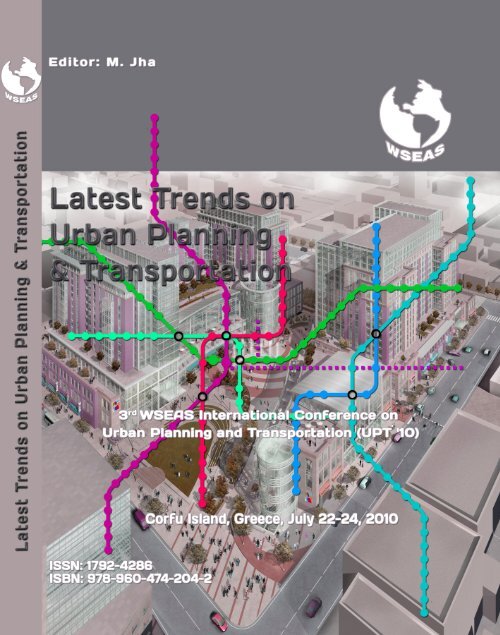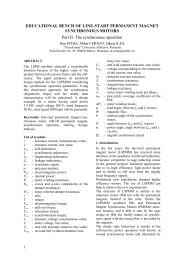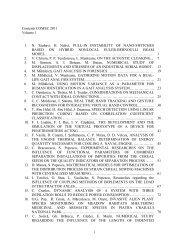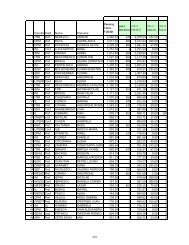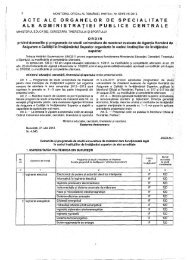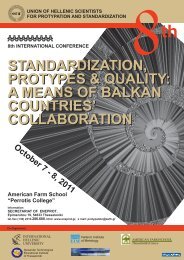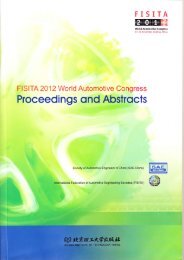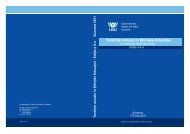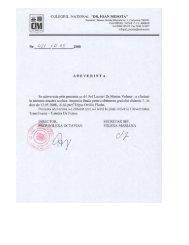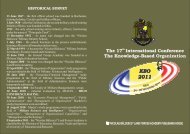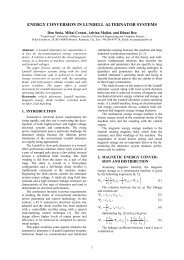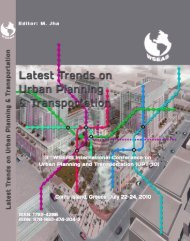LATEST TRENDS on URBAN PLANNING and ... - Portal
LATEST TRENDS on URBAN PLANNING and ... - Portal
LATEST TRENDS on URBAN PLANNING and ... - Portal
- No tags were found...
You also want an ePaper? Increase the reach of your titles
YUMPU automatically turns print PDFs into web optimized ePapers that Google loves.
<str<strong>on</strong>g>LATEST</str<strong>on</strong>g> <str<strong>on</strong>g>TRENDS</str<strong>on</strong>g> <strong>on</strong> <strong>URBAN</strong><strong>PLANNING</strong> <strong>and</strong> TRANSPORTATION3rd WSEAS Internati<strong>on</strong>al C<strong>on</strong>ference <strong>on</strong> <strong>URBAN</strong> <strong>PLANNING</strong> ANDTRANSPORTATION (UPT '10)Corfu Isl<strong>and</strong>, GreeceJuly 22-24, 2010Mathematics <strong>and</strong> Computers in Science EngineeringA Series of Reference Books <strong>and</strong> TextbooksPublished by WSEAS Press ISSN: 1792-4286www.wseas.org ISBN: 978-960-474-204-2
<str<strong>on</strong>g>LATEST</str<strong>on</strong>g> <str<strong>on</strong>g>TRENDS</str<strong>on</strong>g> <strong>on</strong> <strong>URBAN</strong><strong>PLANNING</strong> <strong>and</strong> TRANSPORTATION3rd WSEAS Internati<strong>on</strong>al C<strong>on</strong>ference <strong>on</strong> <strong>URBAN</strong> <strong>PLANNING</strong> ANDTRANSPORTATION (UPT '10)Corfu Isl<strong>and</strong>, Greece, July 22-24, 2010Mathematics <strong>and</strong> Computers in Science EngineeringA Series of Reference Books <strong>and</strong> TextbooksPublished by WSEAS Presswww.wseas.orgCopyright © 2010, by WSEAS PressAll the copyright of the present book bel<strong>on</strong>gs to the World Scientific <strong>and</strong> Engineering Academy <strong>and</strong>Society Press. All rights reserved. No part of this publicati<strong>on</strong> may be reproduced, stored in a retrievalsystem, or transmitted in any form or by any means, electr<strong>on</strong>ic, mechanical, photocopying, recording, orotherwise, without the prior written permissi<strong>on</strong> of the Editor of World Scientific <strong>and</strong> Engineering Academy<strong>and</strong> Society Press.All papers of the present volume were peer reviewed by two independent reviewers. Acceptance wasgranted when both reviewers' recommendati<strong>on</strong>s were positive.See also: http://www.worldses.org/review/index.htmlISSN: 1792-4286ISBN: 978-960-474-204-2World Scientific <strong>and</strong> Engineering Academy <strong>and</strong> Society
<str<strong>on</strong>g>LATEST</str<strong>on</strong>g> <str<strong>on</strong>g>TRENDS</str<strong>on</strong>g> <strong>on</strong> <strong>URBAN</strong><strong>PLANNING</strong> <strong>and</strong> TRANSPORTATION3rd WSEAS Internati<strong>on</strong>al C<strong>on</strong>ference <strong>on</strong> <strong>URBAN</strong> <strong>PLANNING</strong> ANDTRANSPORTATION (UPT '10)Corfu Isl<strong>and</strong>, GreeceJuly 22-24, 2010
Editors:Prof. Manoj Jha, UNITED STATESInternati<strong>on</strong>al Program Committee Members:Azami Zaharim, MALAYSIABlaise Nsom, FRANCEDimitrios Pavlou, GREECEC Booth, UKR Br<strong>and</strong>tweiner, AUSTRIAEnrique Arias, SPAINFaridatulazna Ahmad Shahabuddin, MALAYSIAGavriletea Marius, ROMANIAGherghinescu Sorin, ROMANIAG Fadda, CHILES Macedo, BRAZILBruno Grbac, CROATIAClaudio Guarnaccia, ITALYCruceanu Catalin, ROMANIADavid Greiner, SPAINHoratiu Teodorescu, ROMANIAKhan Amanat, BANGLADESHKuei-Yang Wu, TAIWANM.Reza Emami Azadi, IRANMadalina Calbureanu, ROMANIAMatthew Karlaftis, GREECEMichelle Duffy, AUSTRALIAMircea Badescu, ROMANIAMurude Celikag, CYPRUSRoxana Marinescu, ROMANIASaeed-Reza Sabbagh Yazdi, IRANSeyed Yousef Sadjadi, UNITED KINGDOMShahriar Quayyum, BANGLADESHSlavka Zekovic, SERBIASmar<strong>and</strong>a Adina Cosma, ROMANIAS<strong>on</strong>ia Degeratu, ROMANIAVassilis Gekas, GREECEAbir Kassem, EGYPTAgita Livina, LATVIAAhadollah A'zami, IRANAndr<strong>on</strong>iki Tsouchlaraki, GREECEAng-cheng kris Ho, TAIWANAsghar Mohammad Moradi, IRANXin Wang, CHINA
PrefaceThis year the 3rd WSEAS Internati<strong>on</strong>al C<strong>on</strong>ference <strong>on</strong> <strong>URBAN</strong> <strong>PLANNING</strong> ANDTRANSPORTATION (UPT '10) was held <strong>on</strong> Corfu Isl<strong>and</strong>, Greece, July 22-24, 2010. Thec<strong>on</strong>ference remains faithful to its original idea of providing a platform to discuss urban planningstrategy <strong>and</strong> development, social differences <strong>and</strong> urbanizati<strong>on</strong>, envir<strong>on</strong>mental protecti<strong>on</strong>,intelligent urban planning systems, transportati<strong>on</strong> in the modern city, urban tourism, sustainablemarine ecosystems, climate <strong>and</strong> global change, cleaner energy systems, energy c<strong>on</strong>servati<strong>on</strong> inindustry, air polluti<strong>on</strong> <strong>and</strong> its effects <strong>on</strong> ecosystems, soil <strong>and</strong> agricultural issues, l<strong>and</strong>scapearchitecture, transportati<strong>on</strong> systems <strong>and</strong> envir<strong>on</strong>ment, transportati<strong>on</strong> engineering, public health<strong>and</strong> transportati<strong>on</strong>, c<strong>on</strong>structi<strong>on</strong>-design of roads, airports <strong>and</strong> harbours design, fuels <strong>and</strong> fuelspolicy, air <strong>and</strong> noise polluti<strong>on</strong>, influence of transportati<strong>on</strong> systems <strong>on</strong> real estate, transportati<strong>on</strong>in extreme weather c<strong>on</strong>diti<strong>on</strong>s etc. with participants from all over the world, both from academia<strong>and</strong> from industry.Its success is reflected in the papers received, with participants coming from several countries,allowing a real multinati<strong>on</strong>al multicultural exchange of experiences <strong>and</strong> ideas.The accepted papers of this c<strong>on</strong>ference are published in this Book that will be indexed by ISI.Please, check it: www.worldses.org/indexes as well as in the CD-ROM Proceedings. They willbe also available in the E-Library of the WSEAS. The best papers will be also promoted in manyJournals for further evaluati<strong>on</strong>.A C<strong>on</strong>ference such as this can <strong>on</strong>ly succeed as a team effort, so the Editors want to thank theInternati<strong>on</strong>al Scientific Committee <strong>and</strong> the Reviewers for their excellent work in reviewing thepapers as well as their invaluable input <strong>and</strong> advice.The Editors
Table of C<strong>on</strong>tentsPlenary Lecture 1: Strategies of Urban Polluti<strong>on</strong> Diminishing by C<strong>on</strong>trolling Emissi<strong>on</strong>s ofAutomotive EnginesCorneliu Cofaru11Plenary Lecture 2: Traffic Incident Management System in Urban Area 12Sadko M<strong>and</strong>zukaPlenary Lecture 3: Analysis <strong>and</strong> CFD Simulati<strong>on</strong> of Flooding Flows <strong>and</strong> Scouring AroundBridges <strong>and</strong> Transportati<strong>on</strong> StructuresM. Kostic13Plenary Lecture 4: Blends of Gasoline-Ethanol, Methanol used in Internal Combusti<strong>on</strong> Engine 15Charalampos ArapatsakosEc<strong>on</strong>omic Feasibility of a Rainwater Recovery System - Case Study for a Residential Area inPortugalCristina Matos, Julia Lourenco, Luis Ramos, Tiago Pinto, Isabel Bentes17Naturalistic Forest L<strong>and</strong>scape in Urban Areas: Challenges <strong>and</strong> Soluti<strong>on</strong>s 21Ilze Jankovska, Inga Straupe, Thomas PanagopoulosTraffic Flow Simulati<strong>on</strong> by 2D Macro- <strong>and</strong> Microscopic Models 27Boris Chetverushkin, Natalia Churbanova, Ilya Furmanov, Marina TrapeznikovaAn Urban Chemical Disaster Traffic Simulati<strong>on</strong> Model: A Case Study for No-noticeEmergency Evacuati<strong>on</strong> DevelopmentEvangelos I. Kaisar, Scott A. Parr, Panagiotis Scarlatos33Direct Solar <strong>and</strong> Diffuse Daylight Analysis for Apartment Buildings in Urban Planning 48Hendrik Voll, Teet-Andrus Koiv, M<strong>on</strong>ika SergejevaThe Renewal Planning of Migrant Community in Urban Fringe: A Comparis<strong>on</strong> Between theChina <strong>and</strong> FranceWang Ting53Post-Socialist Transiti<strong>on</strong> <strong>and</strong> Spatial Development of Serbia 60Miodrag Vujosevic, Slavka Zekovic, Tamara MaricicA Frequent Complain: Cracking of C<strong>on</strong>crete in Slabs-<strong>on</strong>-Ground 66Andreea MirceaRP Surveys <strong>on</strong> Socio-Ec<strong>on</strong>omic, Demographic Characteristics <strong>and</strong> C<strong>on</strong>sumer Behaviour in aMiddle-Sized City. An Integrated System of Models to Forecast Freight Dem<strong>and</strong> <strong>and</strong>Passengers Dem<strong>and</strong> for Purchase TripsFederica Crocco, Salvatore De Marco, Pietro Iaquinta, Domenico M<strong>on</strong>gelli70Strategies of Urban Polluti<strong>on</strong> Diminishing by C<strong>on</strong>trolling Emissi<strong>on</strong>s of Automotive Engines 76Corneliu Cofaru
Data Acquisiti<strong>on</strong> Methods for Estimate the Noise Generated by the Road Traffic 82Daniela Florea, Corneliu Cofaru, Dinu Covaciu, Janos TimarAspects Regarding the Road Traffic Noise <strong>and</strong> Its Effect <strong>on</strong> the Populati<strong>on</strong> 86Dinu Covaciu, Corneliu Cofaru, Daniela Florea, Janos TimarDefining Semantic Relati<strong>on</strong>s in the Domain of Traffic Engineering: Urban Transport 92Mihaela PopescuThe Methodology of Chemical Pollutants Approximati<strong>on</strong> Model 96Stelian Tarulescu, Corneliu CofaruProject Management for an Earthquake Risk Resp<strong>on</strong>se 102Virgil Popa, Dorina Tanasescu, Marius Gatej, Madalina BarnaPreliminary Study for Implementati<strong>on</strong> of L<strong>on</strong>g Lasting Flexible Road Pavements in Romania 111Andrei Radu, Ioan Tanasele, Elena PuslauResearch <strong>and</strong> Studies of L<strong>and</strong> Informati<strong>on</strong> System in Some European Countries – EfficientTool to Underst<strong>and</strong> <strong>and</strong> Manage Urban Development in RomaniaSorin I. Herban117L<strong>and</strong>scape Evaluati<strong>on</strong> as an Integrant Part of the Rehabilitati<strong>on</strong> Process in Urban L<strong>and</strong>scapes 123Bibiana Rodrigues Ramos, Thomas PanagopoulosDevelopment of CFD Simulati<strong>on</strong> for 3-D Flooding Flow <strong>and</strong> Scouring Around a BridgeStructureB. R. Tulimilli, P. Majumdar, M. Kostic, S. A. Lottes129Geoinformati<strong>on</strong> Support – Impact <strong>on</strong> Urban Planning, Envir<strong>on</strong>ment <strong>and</strong> Society 136Carmen GreceaAnalysis of Agricultural Water-Saving Potential of H<strong>and</strong>an 142Lixin He, Xiaoqiang Jia, Lina WangFeasibility of Rainwater Utilizati<strong>on</strong> of H<strong>and</strong>an City 147Lixin He, Xiaoqiang Jia, Lina WangA Novel Parking Soluti<strong>on</strong> for Metropolitan Parking Garages 153Vikas Ganjigunte Ashok, Ajay Gupta, S<strong>and</strong>eep Shiva, Hersh Iyer, Darshan Gowda, Srinivas A.The Behaviour of a Metropolis-Hastings Algorithm under Different Prior Distributi<strong>on</strong>s: AnApplicati<strong>on</strong> to Oz<strong>on</strong>e Measurements in Mexico CityJorge A. Achcar, Gisela Ortiz-Rodriguez, Eliane R. Rodrigues160The Relati<strong>on</strong>ship Between Housing Market <strong>and</strong> the Financial Crisis 166Milena Lopreite, Ant<strong>on</strong>io ScarpinoA Cellular Automata Model for Fire Spreading Predicti<strong>on</strong> 173Joseph Quartieri, Nikos E. Mastorakis, Gerardo Iann<strong>on</strong>e, Claudio GuarnacciaPort Management Importance in Port Activities Development 180Mihaela-Carmen Muntean, Daniela Nechita, Costel Nistor, Daniela SarpeAuthors Index 186
Latest Trends <strong>on</strong> Urban Planning <strong>and</strong> Transportati<strong>on</strong>drawing (Fig. 2). The streets layer in the AutoCADmap was not enough for the needs of LimA. Eachstreet must be broken in segments with the sametraffic data. A street segment is a linear noise source[1]. The sec<strong>on</strong>d map source was the digital mapROAD 2006 (Fig. 3); this was the main source forthe streets segmentati<strong>on</strong>. The buildings wereextracted from the initial AutoCAD drawing, <strong>and</strong>other buildings were added based <strong>on</strong> the orto-photomap. The green areas inside the city were drawnbased <strong>on</strong> the orto-photo map. The total surface of thegreen areas covers about 14% of the city.A big problem was the terrain model, since theinitial drawing didn’t include enough informati<strong>on</strong>.Some additi<strong>on</strong>al curves were drawn using existingtopographic maps as model (paper <strong>and</strong> digital maps).The altitude interval between the level curves wasestablished to 2 meters [15]. Initially, the levelcurves were 2D polylines, <strong>and</strong> altitude informati<strong>on</strong>was added as text entities in the drawing. Using acustom functi<strong>on</strong> (AutoLISP), the altitudeinformati<strong>on</strong> was extracted from the text entities <strong>and</strong>added to the 2D polyline as elevati<strong>on</strong> – this is ast<strong>and</strong>ard property of the AutoCAD objects. This wasthe digital terrain layer.The building layer is composed by closed polylines(<strong>on</strong>e entity for each building). The height of eachbuilding is added as thickness, which is also ast<strong>and</strong>ard property. Using the st<strong>and</strong>ard properties forAutoCAD entities is c<strong>on</strong>venient because are easilytransferred to LimA software, through DXF files.Unfortunately, some additi<strong>on</strong>al data cannot betransferred through the same DXF file. These are,for the building layer, the type of each building(industrial building, medical or educati<strong>on</strong>alinstituti<strong>on</strong>, residential buildings), the number ofinhabitants <strong>and</strong> dwellings in case of the residentialbuildings.The metadata can be stored in the drawing using theActiveX functi<strong>on</strong>s [7], <strong>and</strong> then exported to LimAusing Access tables. The link between the Accesstable <strong>and</strong> the AutoCAD objects is assured by an IDfield, which is the h<strong>and</strong>le of the entity, unique in adrawing.The streets layer (Fig. 4) is composed by openpolylines according to [10]. Since each segmentshould c<strong>on</strong>tain specific data related to vehicle traffic,it was decided to use a single line entity for eachstreet segment. The noise mapping software (Lima)accepts both polylines <strong>and</strong> lines. Each line entity hasthe traffic data associated as custom properties, ormetadata.Fig.2 - Aerial view <strong>and</strong> “street” layerFig.3 - ROAD 2006 map (main source for streetssegmentati<strong>on</strong>)There are three types of streets: main streets,c<strong>on</strong>necti<strong>on</strong> streets <strong>and</strong> residential streets. The trafficdata for residential streets are the same for all thesegments, <strong>and</strong> also for the c<strong>on</strong>necti<strong>on</strong> streets. In caseof the main streets, traffic data was collected orestimated for each segment, <strong>and</strong> there are moremetadata associated.Fig.4 - The streets layer, detailIt is important to menti<strong>on</strong> that the additi<strong>on</strong>alinformati<strong>on</strong> associated to the geometric entitiesISSN: 1792-4286 87 ISBN: 978-960-474-204-2
Latest Trends <strong>on</strong> Urban Planning <strong>and</strong> Transportati<strong>on</strong>makes the drawing larger <strong>and</strong> the regenerati<strong>on</strong>process much slower. It is not easy to maintain thebalance between the volume of metadata <strong>and</strong> thecalculati<strong>on</strong> speed.The entities in the other layers (like terrain model<strong>and</strong> green areas) d<strong>on</strong>’t c<strong>on</strong>tain additi<strong>on</strong>al data. In(Fig. 5) is represented a part of the complete basemap, with all the layers included.Fig.5 - The complete base map, detailthe result. On the other h<strong>and</strong>, there was a limitati<strong>on</strong>found when trying to plot the resulted map <strong>on</strong> alarge format (ISO A0) – the user c<strong>on</strong>trol is quitepoor <strong>and</strong> it was not possible to c<strong>on</strong>figure LimA forplotting <strong>on</strong> that format. Taken these facts intoc<strong>on</strong>siderati<strong>on</strong>, it was chosen to do the postprocessing outside the simulati<strong>on</strong> software, usingcustom software developed by the team members.The development platform was againAutoCAD/AutoLISP.After the first simulati<strong>on</strong> was d<strong>on</strong>e <strong>and</strong> the firstversi<strong>on</strong> of the noise map ready, the values obtainedwas compared with the noise values measured <strong>on</strong>site (see the feedback line in Fig. 1). Some of themeasuring <strong>and</strong> validati<strong>on</strong> points are shown in (Fig.7). The measuring points are in most cases the sameor nearest the points where traffic volumes wasmeasured.3. Calculati<strong>on</strong>As menti<strong>on</strong>ed before, the input data for thesimulati<strong>on</strong> software (LimA) are stored in Accesstables, which are c<strong>on</strong>nected to the AutoCADdrawings using the entities h<strong>and</strong>le. The base maplayers are imported in LimA through DXF files. Forthe buildings, the height informati<strong>on</strong> is sent as colorproperty (the c<strong>on</strong>versi<strong>on</strong> between thickness <strong>and</strong>color was d<strong>on</strong>e previously <strong>on</strong> the AutoCADdrawing) – (Fig. 6).Fig.7 - Measuring pointsIn case of differences greater than 3 dB(measurement versus simulati<strong>on</strong> result), the inputdata was corrected <strong>and</strong> the calculati<strong>on</strong> process wasrepeated until the differences were fitted in theapproved domain.Fig.6 - Buildings prepared for LimAAfter importing the geometry some checks should bed<strong>on</strong>e in LimA: closing polyg<strong>on</strong>s to ensure thecorrect modeling, especially for buildings;recognizing <strong>and</strong> preventing multiple existences ofobjects; linking objects to prevent gaps in the model;smoothing polyg<strong>on</strong>s to reduce the number of vectors<strong>and</strong> speed up calculati<strong>on</strong>s [16].The whole city was split in 97 tiles, each tilec<strong>on</strong>taining up to 10,200 grid points, the distancebetween points being 10 meters. The calculus is verycomplex <strong>and</strong> time c<strong>on</strong>suming; for a single run ittaken almost 48 hours (<strong>on</strong>ly the running time, notincluding the data preparati<strong>on</strong> <strong>and</strong> visualizati<strong>on</strong> of4. Post processing <strong>and</strong> resultsThe output of LimA includes the ERT files, text filesthat can be processed with external programs. Insidethe ERT file, each line corresp<strong>on</strong>ds to a point of thecalculati<strong>on</strong> grid. The informati<strong>on</strong> for each point is:X, Y coordinates in km, Lday <strong>and</strong> Lngt (equivalentnoise level for day <strong>and</strong> night respectively), Z(altitude), Levg (equivalent noise level for evening),Lden (equivalent noise level for the whole day). Thealtitude is not useful for plotting the noise map, sothe z coordinate of each point can be the noise level.The color legend for points is defined in 5dBintervals [15]. Finally, each point can berepresenting as a square of 10x10 (10 meters is thesize of calculati<strong>on</strong> grid).The final result is the plotted noise map (Fig. 9),presenting the complex noise informati<strong>on</strong> in a clearISSN: 1792-4286 88 ISBN: 978-960-474-204-2
Latest Trends <strong>on</strong> Urban Planning <strong>and</strong> Transportati<strong>on</strong><strong>and</strong> simple way. In additi<strong>on</strong>, for each noise map(Lden, Lngt) is created a c<strong>on</strong>flict map (Fig. 14).C<strong>on</strong>flict maps show the difference between thepredicted noise level <strong>and</strong> the noise limits (70dB forLden, 60dB for Lngt).Using the noise maps <strong>and</strong> the c<strong>on</strong>flict maps ispossible to identify the hot spots <strong>and</strong> also the quietareas, <strong>and</strong> to estimate the number of annoyed peoplefor Lden <strong>and</strong> Lngt. The quiet areas are defined asareas of at least 4.5 hectares with a maximum noiselevel of 55 dB. In order to identify these areas, it isfirst necessary to c<strong>on</strong>vert the grid cells of the noisemap in noise surfaces. Technically, all the points ofthe grid cells must be c<strong>on</strong>verted in squares <strong>and</strong> thesquares of the same color will compose a surface(the object type is regi<strong>on</strong>). Then the regi<strong>on</strong>s arec<strong>on</strong>verted in closed polylines. The area of a regi<strong>on</strong>or closed polylines can be obtained using st<strong>and</strong>ardAutoCAD requests. Only the c<strong>on</strong>tours with an areagreater than 4.5 hectares <strong>and</strong> a corresp<strong>on</strong>ding noiselevel of less than 55 dB are maintained. An exampleis given in (Fig. 8). Only those quiet areas placed inresidential areas will be taken into c<strong>on</strong>siderati<strong>on</strong>.Here another problem was identified: if the trafficvolume <strong>and</strong> speed for residential streets are usedaccording to [14] <strong>and</strong> [15], the noise level <strong>on</strong> thestreets is over 55 dB <strong>and</strong> these streets interfere withsome possible quiet residential areas.In this phase all the necessary data for ascertainingthe number of people exposed to various noise levelsare established. For each building is known thenumber of inhabitants (stored as metadata). From thenoise map is possible to identify the exposure ofeach façade of the building to each noise level (Fig.10). The grid cells are colored according to theequivalent noise level (intervals of 5 dB). The exactnoise value is stored as Z coordinate of the cell;adding this value as metadata is not a good ideabecause the very high number of cells will make theexecuti<strong>on</strong> of any other comm<strong>and</strong> very slow.Fig.10 - Exposure of the facadesThe first step is to find all the intersecti<strong>on</strong>s betweenthe building c<strong>on</strong>tour lines <strong>and</strong> the squaresrepresenting the grid cells in the noise map. Only thex, y coordinates are used to calculate theintersecti<strong>on</strong>s, because z is the noise value. For eachintersecti<strong>on</strong> found the value of the noise associatedto the respective grid cell is added to a list – theblack list in (Fig. 11). This list is added to thebuilding object in the drawing as metadata.Fig.11 - Metadata associated to a residential buildingFig.8 - Example of a “quiet” area identified: morethan 9 ha under 55 dB, over 500 inhabitantsIn the sec<strong>on</strong>d phase, it is calculated the number ofinhabitants exposed to each 5dB interval of noiselevel, then these values are added to the list ofexposed people (see Fig. 12).Fig.12 - People exposed to different noise levels,calculati<strong>on</strong> resultFig.9 - Noise maps; source: road traffic - Lden (left),Lngt (right)Based <strong>on</strong> these results, difficult to read <strong>and</strong>underst<strong>and</strong> for most people, are created the chartsshown in (Fig. 13). The red bars represent the peopleexposed to a noise level higher than the limitallowed for the respective period (day or night).These red bars are in direct relati<strong>on</strong> with the areasmarked in the c<strong>on</strong>flict maps.ISSN: 1792-4286 89 ISBN: 978-960-474-204-2
Latest Trends <strong>on</strong> Urban Planning <strong>and</strong> Transportati<strong>on</strong>The measures which lead us to the difference map in(Fig. 15) are related <strong>on</strong>ly to the road surfacec<strong>on</strong>structi<strong>on</strong> of the main streets. Other globalmeasures, with significant effects, are difficult to betaken. A detail view of the original <strong>and</strong> the updatednoise maps is given in figure 16.Fig.13 - People exposed to different noise levels,chartFig.15 - Example of a difference mapFig.14 - Part of a c<strong>on</strong>flict map (road traffic noise),detailThe colors used in the c<strong>on</strong>flict maps are: green for anoise level with maximum 5 dB lower than the limit(in Romania the limit for the noise generated by theroad traffic is 70 dB for day/evening/night <strong>and</strong> 60dB for night); red is for a noise level with maximum5 dB higher than the limit <strong>and</strong> blue is for a noiselevel of more than 5 dB over the admitted limit.Based <strong>on</strong> the c<strong>on</strong>flict maps <strong>and</strong> the number ofpeople exposed to high noise level, the localauthorities should propose acti<strong>on</strong> plans for reducingthe noise level <strong>and</strong> its effect <strong>on</strong> the populati<strong>on</strong>.Taken into c<strong>on</strong>siderati<strong>on</strong> the proposed measures,new noise maps can be created <strong>and</strong>, again, thenumber of people exposed to high noise levels canbe ascertained. From the initial <strong>and</strong> the estimatednoise maps it can be generated the difference maps,like the <strong>on</strong>e shown in (Fig. 15). The color scale ofdifference maps is for intervals of 1dB; in the givenexample orange means no change (0 dB), greenmeans a gain of 3-4 dB.Fig.16 - Details of the initial <strong>and</strong> after noise mapIn the map <strong>on</strong> bottom half of figure 16, the intenseblue color (the highest level of noise) was disappear<strong>and</strong>, in general near the main streets, each color isturned into the next lower level. There are nochanges across the buildings which are not close tothe main roads, because the sec<strong>on</strong>dary roads werenot affected by the proposed measures.The difference maps <strong>and</strong> the noise maps post- acti<strong>on</strong>plans are just what could be, not what will be. Onlythe representatives of the local authorities can decideISSN: 1792-4286 90 ISBN: 978-960-474-204-2
Latest Trends <strong>on</strong> Urban Planning <strong>and</strong> Transportati<strong>on</strong>to apply the proposed measures entirely, or just <strong>on</strong>some parts of the city.5. C<strong>on</strong>clusi<strong>on</strong>sRoad noise mapping has usually three phases:preparing the input data (base map <strong>and</strong> traffic dataacquisiti<strong>on</strong>), calculati<strong>on</strong> <strong>and</strong> analysis of the effects(people exposed). Then can be defined acti<strong>on</strong> plansfor reducing the noise in such manner that thenumber of the people exposed to high level of noiseto be reduced significantly. In a classic way, the firstphase is managed using GIS software, the sec<strong>on</strong>d<strong>and</strong> the last phases are d<strong>on</strong>e with the noisecalculati<strong>on</strong> software. We have realized the noisemap in a different way: the first was d<strong>on</strong>e usingAutoCAD <strong>and</strong> some custom applicati<strong>on</strong> developedin AutoLISP; the sec<strong>on</strong>d phase using LimA (noisemapping software) <strong>and</strong> the last phase was d<strong>on</strong>eusing again AutoCAD <strong>and</strong> custom AutoLISPapplicati<strong>on</strong>s.It is very difficult to propose realistic measures forreducing the noise in an urban agglomerati<strong>on</strong>. Manyof the possible measures are related to road trafficmanagement <strong>and</strong> should be integrated in a morecomplex acti<strong>on</strong> plan, not <strong>on</strong>ly intended for noisereducti<strong>on</strong>. So the acti<strong>on</strong> plans is better to be basednot <strong>on</strong>ly <strong>on</strong> the existing noise maps, but also <strong>on</strong> roadtraffic studies.References:[1] CERTU: Road Traffic Noise, New Frenchcalculati<strong>on</strong> method including meteorologicaleffects, NMPB’96, Predicti<strong>on</strong> of RoadTraffic Noise, January 2007.[2] CERTU: Comment réaliser les cartes debruit stratégiques en agglomerati<strong>on</strong>, Mettreen oeuvre la directive 2002/49/CE, CERTU9, rue Juliette Récamier 69456 Ly<strong>on</strong>,France, Reference 58, http://www.certu.fr[3] C. Cofaru,, J. Timar, D. Florea, D. Covaciu,,Study regarding the simulati<strong>on</strong> <strong>and</strong>optimisati<strong>on</strong> of urban traffic noise in Tg.Mureş City, CHER-2009 Intl. C<strong>on</strong>ference,Sozopol 2009.[4] C. Cofaru, J. Timar, D. Florea, D. Covaciu,Study Regarding the Simulati<strong>on</strong> of UrbanTraffic Noise in Braşov City, WSEASC<strong>on</strong>ference of Advances in Envir<strong>on</strong>mental<strong>and</strong> Geological Science <strong>and</strong> Engineering,Transylvania University of Brasov,September 24-26, 2009, pp.154-157.[5] European Commissi<strong>on</strong> Working GroupAssessment of Exposure to Noise (WG-AEN), Good practice guide for strategicnoise mapping <strong>and</strong> the producti<strong>on</strong> ofassociated data <strong>on</strong> noise exposure, Versi<strong>on</strong>2, 13th January 2006[6] European Commissi<strong>on</strong>, Envir<strong>on</strong>ment Dir.:Positi<strong>on</strong> paper <strong>on</strong> EU noise indicators,2000, ISBN 92-828-8953-X. E.C., Belgium.[7] D. Florea, Road Traffic Management (inromanian), Sec<strong>on</strong>d Editi<strong>on</strong>, “Transilvania”University of Brasov Publishing House,2000.[8] D. Covaciu, D. Florea, J. Timar, Strategicnoise-map for Tîrgu-Mureş city, TAIEXRTP 32784, Seminar <strong>on</strong> Envir<strong>on</strong>mentalNoise Management, Târgu Mureş, 2009.[9] D. Covaciu, D. Florea, I. Preda, J. Timar,Using GPS Devices For Collecting TrafficData, SMAT2008 Internati<strong>on</strong>al C<strong>on</strong>ference,Craiova, 2008.[10] D. Covaciu, D. Florea, I. Preda, J. Timar,Gh. Ciolan, Analysis of vehicles travel speedin the completi<strong>on</strong> of noise maps for urbanareas (romanian), Intelligent Transportati<strong>on</strong>Systems ITS,Romania-2009, Internati<strong>on</strong>alC<strong>on</strong>ference, Bucuresti.[11] IMAGINE, Improved Methods forAssessment of the use of traffic models fornoise mapping <strong>and</strong> noise acti<strong>on</strong> planning,Deliverables 1-15, C<strong>on</strong>tract nr. SSPI-CT-2003-503549-IMAGINE.[12] I<strong>on</strong> Preda, Gh. Ciolan, D. Covaciu - SystemsBased <strong>on</strong> GPS Devices Used for VehiclesDynamic- Behaviour Study (in romanian),Intelligent Transportati<strong>on</strong> Systems ITS-Romania-2009, Internati<strong>on</strong>al C<strong>on</strong>ference,Bucuresti[13] Nikolaos, E., K<strong>on</strong>stantinos, V., <strong>and</strong> Fotini,K., Evaluati<strong>on</strong> of Noise Levels in UrbanEnvir<strong>on</strong>ment in Greece, WSEAS Transacti<strong>on</strong>s<strong>on</strong> Envir<strong>on</strong>ment <strong>and</strong> Development,Issue 8, Vol. 2, August 2006, pp.1065-1071.[14] *** OM 678/1344/915/1397, 2006 - Orderof the Ministry for approval of the Guideregarding the interim methods forcalculati<strong>on</strong> the noise indicators, c<strong>on</strong>cerningthe noise generated by industry, road traffic,railway traffic <strong>and</strong> airports.[15] *** OM 1830/2007 – Order of the Ministryfor approval of the Guide for creating,analyzing <strong>and</strong> avaluating the strategic noisemaps.[16] *** Lima 7812 User’s Manual.ISSN: 1792-4286 91 ISBN: 978-960-474-204-2


